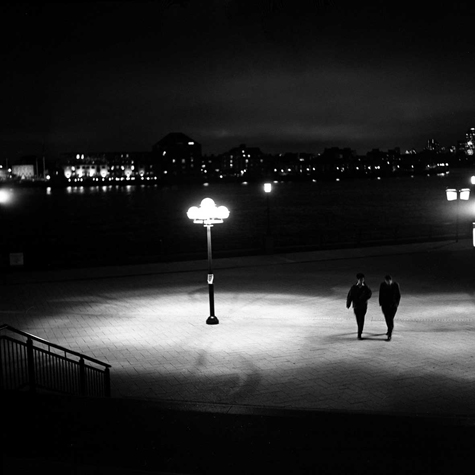Amanda Calluf, Curitiba, Brazil
Born in 1980, in Curitiba, Brazil. Started to photograph in 1998, while studying journalism. Since 2003, dedicates herself to personal projects thinking about issues of contemporary life through photography.
Nightwalks 2007
At night, away from the crowds and the rush that dominates everyday life, the way of relating to a city changes substantially. Wandering through silent and empty streets one enters a distinct kind of time, a slower one, where it is possible to imagine a story for each passer-by. Common places, ignored during the day, are transfigured by artificial lights and darkness. The whole city acquires a new life, beyond reality, dreamlike.

Flâneuse: an experience between times
The project “Flâneuse: an experience between times” is inspired by Baudelaire’s flâneur. The idea is to bring this figure from the 18th century to these days, at its female version, the flâneuse, equipped with a camera. The images’ content would be anything that attracted the attention of this admirer of the simple things of life and of quotidian beauty. She wanders aimlessly through the streets, looking at the city with enchantment, turning it into a dreamed place. But the personification of the flâneuse nowadays, when everything is so fast, brings up several questions. In her slow and fascinated walk, she is jostled by the passers-by, her rhythm is suffocated by urban haste. She tries in vain to observe people, like she would originally, but they pass by too fast for her to imagine one story for every face. She tries to recreate dialogues, but the voices mix up and all she’s got are sounds coming and going. She keeps on walking, trying to identify individuals, but she is taken by vertigo in the middle of the crowd. She walks a little more until she can breathe and suddenly, she is fascinated again by a scene, a light, a detail. But soon she is hit by a stroke of reality and taken away from her particular world. Even though she is fascinated by the crowd, the flâneuse always keeps her individuality. That is why the problems of the modern man touch her deeply when what she sees are people with no identity, running without direction, more dominated by time than by existence itself. People who are part of urban landscape not as characters, but as shadows of what they could have been if they weren’t consumed by a supposed civilization. The city, that would be her refuge, begins to afflict her and her look hesitates between enchantment, despair and disappointment. Outside her context, the flâneuse has nowhere to go, since no house can be a home for her unquiet mind that desperately searches the streets. So she wanders, looking for a life that she will not find, letting herself go with the worlds that she creates when, in moments of ecstasy, she succeeds in transporting herself to a place that doesn’t exist. Amanda Calluf 2006-06








